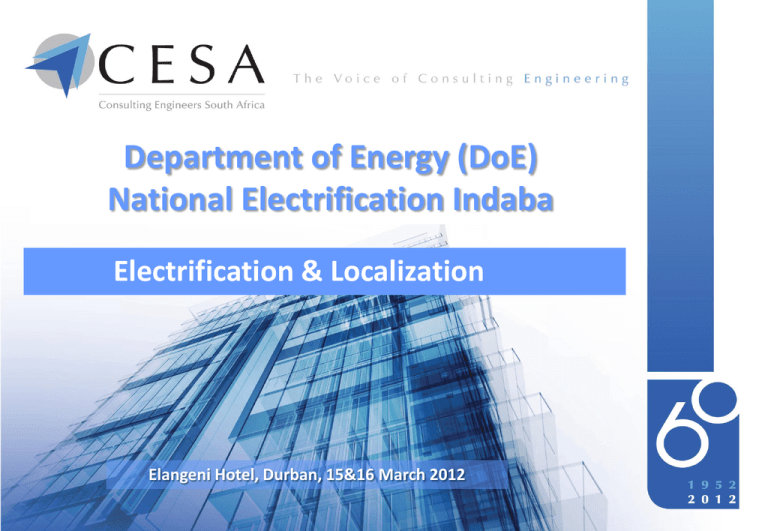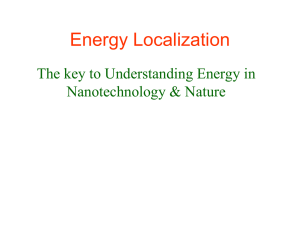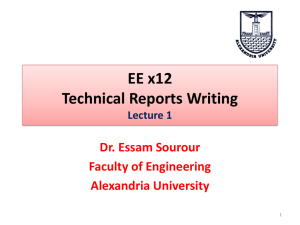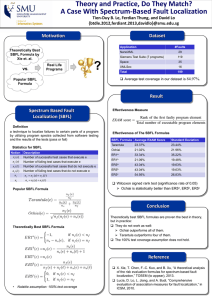NB Presentation - Department Of Energy
advertisement

Department of Energy (DoE) National Electrification Indaba Electrification & Localization Elangeni Hotel, Durban, 15&16 March 2012 Promote interests of Members and Clients by: > South African Association of Consulting Engineers (SAACE) founded in 1952 > Regular liaison meetings > Engineering comment on legislation etc > Original membership 30 individuals > Advisory Notes for Members and Clients > August 2008 - SAACE transformed to Consulting Engineers South Africa (CESA) > New/revised contracts/forms of agreement > Consists of 485 private CE firms – still growing > A peer review and quality management > Employing more than 22 000 people > Seminars, workshops and conferences > Guidelines on professional practice matters programme > FIDIC (International Federation of CE Association) Professionalism and Integrity of Members: 1. In general: • ECSA registers professional individual engineers, technologists etc • CESA ‘registers’professional Consulting Engineering Firms 2. Credibility of applicants • In business > 12 months • Nominated & Seconded by CESA member firms 3. Ongoing requirements • Subject to CESA Code of Conduct (includes BIMS) • Ownership/principals > 50% Professional Engineers/Technologists • Primary work (Consulting Engineering) • implement and maintain a QMS Overview of Presentation > Challenges & Opportunities for Electrification > Electrification & the Engineering Profession > Engineering Contributions to SA’s Infrastructure > How engineer’s can help South Africa > Localization: Definition & Maximization > Localization: CSP Example Limited Generation Plant (Low safety margins) Aging Infrastructure Infrastructure Expansion & Upgrading (Growth, job creation, carbon reduction, localization, diversification etc) (Generation, Transmission, Distribution) Increasing Demand Poverty Elevation & Growth (3 million households not electrified) Rapid increase in electricity cost Sustainable Income for future expansion Energy Efficiency Cost reduction & Greening (reduced revenue from electricity sales) Evolving Government Policy Reform & Modernization (IPP’s, ISMO, small scale renewable etc) Localization Industrialization & Job Creation (technology transfer, industrialization & jobs) Regional (few opportunities for import) Export of SA knowledge & products Shortage of Experienced Engineers Training Young Engineers Aging work force (generational knowledge transfer, greater career opportunities & faster growth for young engineers than in other countries) (loss of experience, knowledge, mentorship) Un-sustained infrastructure investment (leads to loss of local engineering knowledge) Limited Technology Transfer (limited development of new engineering skills in SA) Moral & Professional Duty to SA Maintaining & Growing Knowledge through sustained investment in new technologies (Nuclear & Renewable) Receiving Technological Knowledge from Developed Economies & transferring to other African nations Role Models & Leaders in Developing our Nation through our Work Despite challenges South African Engineers, contractors and manufacturers have delivered challenging new projects to Government in the recent past … SA’s Engineers can bring guidance to Government policy: SA’s Engineers bring valuable local knowledge to the project: > Technical and economic assessment of existing infrastructure > Projections for infrastructure investment > Feasibility studies > Tender evaluations > Localization potential & requirements > Education policy on developing the engineering profession > Training of government’s technical staff > Regional integration > Multi-discipline engineering services (mechanical, electrical, structures, civil, nuclear ..) > Local Design & Building Standards > Local site conditions (geotechnical, seismic, wind etc). > Local Regulations (Building, Environmental, Legal, Water, Electricity use etc. etc.) > Knowledge of local construction techniques & materials > Local site supervision, project management & bid bid preparation > Grid connections & sub-stations to Eskom Standards > Strong ties with local construction & manufacturing industries, government & Eskom > Supported by robust industry institutions like CESA, NIASA, SASTELA, SAICE etc) > History of successful collaboration with foreign vendors & engineers Localization is the transfer of new technologies from technology providers (typically from developed countries) to local market (typically developing countries). Complete transfer involves the knowledge to design, manufacture and install the technology as well adapt and further develop the technology. Localization creates jobs in design (engineering), manufacturing and construction, thereby stimulating growth, alleviating poverty and ensuring a sustainable economy. Technologies can be adapted and exported to other African countries. If other African countries follow South Africa’s lead in electricity policy, with regional integration a bigger market will form, encouraging specialization. South Africa could become a leading exporter of technology and engineering services. Regulation & Tender Criteria Encouraging Technology Transfer not only in Manufacturing but also Engineering Policy and implementation for providing small scale projects (own generation, off grid etc) Off grid small scale applications for electrification of rural households. Giving preference to technologies that have a higher potential for localization Giving preference to technologies that have a high potential for further development Maximizing the market for technologies through policy certainty and assigning enough MW to the technology to build a local engineering & manufacturing base Offering attractive return on investment for technology vendors to invest in SA. Problems with current IRP allocation & policy: > 1000 MW allocation in IRP2010 (~100MW/ per year) > Undersubscribed compared to wind (8400MW) and PV (8400MW) > Allocation to sufficient to maximize localization (200MW/year required) > Project scale could be increased to up to 250MW/plant maximize economies of scale > Tarrifs in direct competition with cheaper PV, does not recognize CSP advantages for energy storage (dispatchibility) and localization potential Advantages Greater Localization Potential (up to 60% immediately, 80% long term) Manufacturing can be implemented in existing factories (steel & car industry) Larger component for local civil & structural and mechanical engineering Energy storage option (base load & dispatchibility) Adopted by Eskom and Sasol Commonalities in design with thermal power stations (power blocks, heat exhangers etc) Utility Scale (up to 250MW) HTF; 4.7% Instrumentation; 0.2% Inter Loop Piping Installation; 2.8% Inter Loop Piping Material; 3.2% Further development potential SCA Foundations; 4.4% Header Piping Installation; 2.1% Header Piping Material; 4.5% Metal Support Structure (incl. Huckbolts); 24.2% Swivel Joints assemblies; 1.7% SF Power Supply; 0.3% SF Cabling (Supply & Installation); 2.4% LOC, FSC & Meteo Station; 1.3% Sensors & Pylon Cabling; 0.7% Drive Units; 1.2% Local O & M Mirrors; 13.9% SF Assembly & Erection; 10.6% SCE Assembly Line incl. Photogr.; 3.0% Exportable to neighbouring countries Implemented in high DNI areas where water use will not grow Dramatically due to low population density 60 HCE; 17.1% License ( Collector Drawings ); 1.4% Adaptable Process heat for local 50 industries 40 Electric output (MW) Labour intensive manufacturing 30 Built in poor developed areas 20 10 0 Thermal boosting for existing coal fired power stations 012345678910 Hour 11 213141of 5161the 718192day 02122 324











